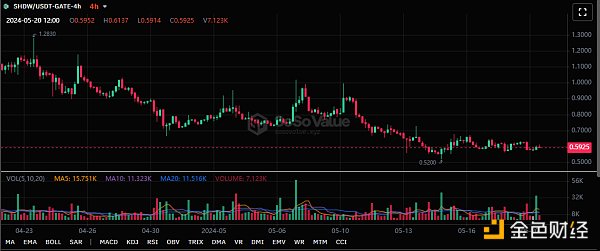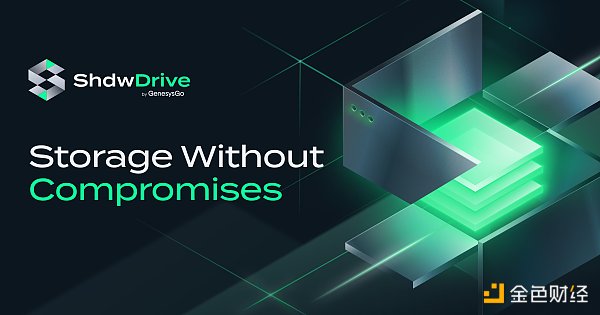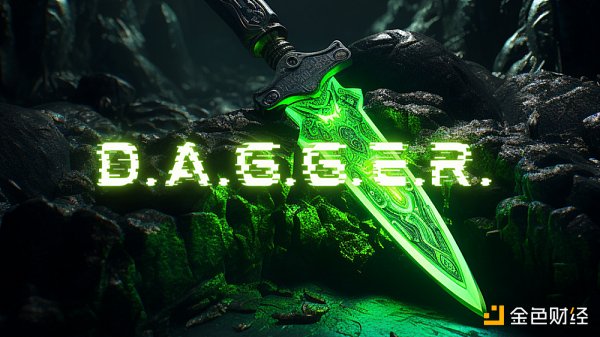Which decentralized cloud computing platform is the best? New projects may bring a new experience to users
Shadow (SHDW) tokens are utility tokens that support the Shadow dePIN ecosystem, focusing on decentralized storage, computing, and network orchestration. SHDW is used to pay for services within the ecosystem, supporting decentralized data storage and other practical functions. As of now, the real-time price of SHDW is $0.5955, with a 24-hour trading volume of approximately $628,020, down 4.08%. In SoSoValue, the market value ranking is #415, with a market value of $9.58 million, a circulating supply of 16.09 million SHDW coins, and a maximum supply of 169.05 million SHDW coins.

Shadow is a stable, high-performance cloud platform developed by GenesysGo, supported by a decentralized network of operators. Shadow Drive is a decentralized, high-performance and scalable object storage designed for Web3 builders. Third-party storage solutions such as Arweave and Filecoin are often used for storage activities such as NFT on Solana, but they are not compatible with Solana and use their own tokens for payment. Shadow Drive is the native storage system of the Solana ecosystem, designed to meet Solana's growing demand for storage in the ecosystem.
In this article, we will take a deep look at the specifics of the SHDW token, including its importance as a means of payment within the ecosystem, and its role in promoting ecosystem development and user participation. Next, we will explore various aspects of the Shadow project and its token SHDW in detail so that readers can better understand this unique blockchain project.
Introduction to Shadow Drive: A decentralized data storage layer based on the Solana ecosystem
Shadow Drive is a decentralized data storage layer in the Solana ecosystem, designed to meet the growing storage needs of the Solana ecosystem. In the past, third-party storage solutions such as Arweave and Filecoin were often used for storage activities such as NFTs. However, these solutions are often independent storage public chains that are not compatible with Solana and therefore cannot keep pace with Solana's speed. To solve this problem, the Solana ecosystem urgently needs a native storage system, so Shadow Drive came into being.
Shadow Drive is a storage program adapted from open source software Ceph, which is an open source software that provides a unified software-defined solution that supports block storage, file storage, and object storage. Its effectiveness has been widely verified. The GenesysGo team combined Ceph's open source solution with Solana's PoH (Proof of History) mechanism to create Shadow Drive. Users can upload data to Shadow Drive by paying a small $SHDW fee.

On the other hand, the ShdwDrive platform is a high-performance cloud storage platform developed by GenesysGo, fully supported by a decentralized network of operators and fully integrated with the Solana blockchain. The platform uses Solana's innovative Proof of History (PoH) consensus mechanism to ensure the order and integrity of blocks through time series, thereby improving data security. ShdwDrive also provides fast batch upload capabilities and a content delivery network (CDN) to ensure that users can efficiently upload and access data stored on the platform. In addition, ShdwDrive also provides a wealth of development tools and interfaces, including a command line interface (CLI) and a multi-language software development kit (SDK) to meet the needs of developers.
The core technology of the ShdwDrive platform is the DAGGER consensus engine, which is a trustless decentralized consensus protocol. DAGGER uses a directed acyclic graph (DAG) data structure to provide efficient data storage and management for data-intensive applications. Compared with traditional blockchains, DAGGER has the characteristics of parallel processing of data tasks, no need to wait for block confirmation, and dynamic adjustment, thereby improving the performance and scalability of the system. Compared with other traditional platforms, DAGGER has higher throughput, faster response speed and higher efficiency, which makes the ShdwDrive platform an indispensable part of the Solana ecosystem.
Understand ShdwDrive's economic model and value proposition and find your own opportunities
ShdwDrive hopes to create a stable, valuable and sustainable long-term community. The most important means to achieve this vision is its token economic model that aims to bring value to network users and long-term SHDW holders. By reducing the velocity of tokens, adopting a halving schedule and rewarding SHDW holders for participating in protecting and expanding the ShdwDrive network, and adopting a shared staking and slashing mechanism to enhance network stability and increase community participation, the economic management method of the ShdwDrive platform aims to transform token holders into active participants, actively participate in protecting the network, and benefit all stakeholders.
Rewarding holders for participating in the network through staking is a core component of the overall design process of the ShdwDrive economic system, which will create value for both the network and holders. As the foundation of the SHDW network, shdwNode operators must stake SHDW to secure their position in the network before connecting their servers to the ShdwDrive network and receiving rewards, which is used as a commitment fee to ensure that serious and dedicated participants manage the network. When an shdwNode is slashed, the wallet associated with the node will be penalized and lose 5% of its staked SHDW. For ordinary SHDW holders, they can delegate their SHDW tokens to shdwNode operators through smart contracts and then share the rewards received by the node. This shared success model promotes community connections and motivates both parties to actively contribute to the growth of the network.

Most of the fees paid by end users of ShdwDrive (60-75%) are passed directly to the operators running shdwNode as rewards and compensation for individuals, groups of individuals or entities that own the actual servers. This part of the income is not shared with the SHDW holder program that delegates their tokens to the shdwNode operator. The remaining fees paid for storage will be used to purchase SHDW on the open market and send the purchased SHDW to the release pool. This repurchase mechanism helps maintain the liquidity of the SHDW token market and ensures that there is a clear and verifiable connection between ShdwDrive revenue growth and the value of the SHDW token, aiming to make the ShdwDrive network token economy as sustainable as possible in the long term.
A method to control supply and enhance the value of SHDW. The project proposes that 7,000,000 SHDW tokens be sent back to the team, locked into a smart contract, and will be released over time. According to the current model, the release amount paid to ShdwOperators (shdwNode and Audit Node operators) each year is 1,400,000 - 2,000,000 SHDW. This amount will be halved every two years, reducing the number of new tokens entering the market. The project believes that this scarcity mechanism may increase the value of SHDW over time because it encourages network participants to become early supporters of ShdwDrive and DAGGER technology and creates a sense of urgency by offering higher rewards to early supporters.

In the emerging crypto economy, ShdwDrive's economic model provides an innovative way to incentivize community participation and holding while ensuring the health and sustainability of the network. By rewarding participants who actively contribute to the network and maintaining token value through supply control and revenue distribution, ShdwDrive's economic management approach is designed to promote long-term community building and network growth.
Shadow Drive may bring more innovative changes to the Web3 world, and its future trend is worth paying attention to
This article introduces the Shadow platform in the Solana ecosystem and the related ShdwDrive platform, both of which are decentralized data storage solutions designed to meet the growing storage needs of the Solana ecosystem.
Shadw Drive is based on the open source software Ceph and combined with Solana's PoH mechanism to provide users with storage services supported by the native token $SHDW. ShdwDrive is a high-performance cloud storage platform developed by GenesysGo, which is fully integrated with the Solana blockchain and uses its innovative PoH consensus mechanism to ensure data security. It also provides fast batch upload capabilities and content delivery networks (CDNs), as well as a wealth of development tools and interfaces.
To sum up, the emergence of Shadow platform and ShdwDrive platform has brought new storage solutions to the Solana ecosystem, and also brought more possibilities and opportunities to the game ecosystem. In the future, with the continuous development and improvement of these platforms, it will bring more convenience and innovation to users and developers.
 JinseFinance
JinseFinance











